纳米油气与源储共生型油气聚集_邹才能
中国非常规油气沉积学新进展——“非常规油气沉积学”专辑前言
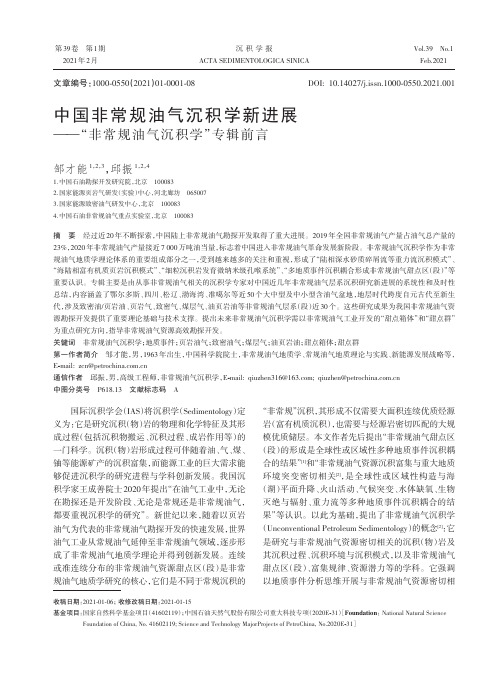
第39卷第1期2021年2月Vol.39No.1Feb.2021沉积学报ACTA SEDIMENTOLOGICA SINICA中国非常规油气沉积学新进展——“非常规油气沉积学”专辑前言邹才能1,2,3,邱振1,2,41.中国石油勘探开发研究院,北京1000832.国家能源页岩气研发(实验)中心,河北廊坊0650073.国家能源致密油气研发中心,北京1000834.中国石油非常规油气重点实验室,北京100083摘要经过近20年不断探索,中国陆上非常规油气勘探开发取得了重大进展。
2019年全国非常规油气产量占油气总产量的23%,2020年非常规油气产量接近7000万吨油当量,标志着中国进入非常规油气革命发展新阶段。
非常规油气沉积学作为非常规油气地质学理论体系的重要组成部分之一,受到越来越多的关注和重视,形成了“陆相深水砂质碎屑流等重力流沉积模式”、“海陆相富有机质页岩沉积模式”、“细粒沉积岩发育微纳米级孔喉系统”、“多地质事件沉积耦合形成非常规油气甜点区(段)”等重要认识。
专辑主要是由从事非常规油气相关的沉积学专家对中国近几年非常规油气层系沉积研究新进展的系统性和及时性总结,内容涵盖了鄂尔多斯、四川、松辽、渤海湾、准噶尔等近50个大中型及中小型含油气盆地,地层时代跨度自元古代至新生代,涉及致密油/页岩油、页岩气、致密气、煤层气、油页岩油等非常规油气层系(段)近30个。
这些研究成果为我国非常规油气资源勘探开发提供了重要理论基础与技术支撑。
提出未来非常规油气沉积学需以非常规油气工业开发的“甜点箱体”和“甜点群”为重点研究方向,指导非常规油气资源高效勘探开发。
关键词非常规油气沉积学;地质事件;页岩油气;致密油气;煤层气;油页岩油;甜点箱体;甜点群第一作者简介邹才能,男,1963年出生,中国科学院院士,非常规油气地质学、常规油气地质理论与实践、新能源发展战略等,E -mail:******************.cn通信作者邱振,男,高级工程师,非常规油气沉积学,E -mail:******************;**********************.cn中图分类号P618.13文献标志码A国际沉积学会(IAS )将沉积学(Sedimentology )定义为:它是研究沉积(物)岩的物理和化学特征及其形成过程(包括沉积物搬运、沉积过程、成岩作用等)的一门科学。
唯厚“才”世界一流__唯新“能”基业长青——记中国科学院院士、非常规与新能源探索者邹才能
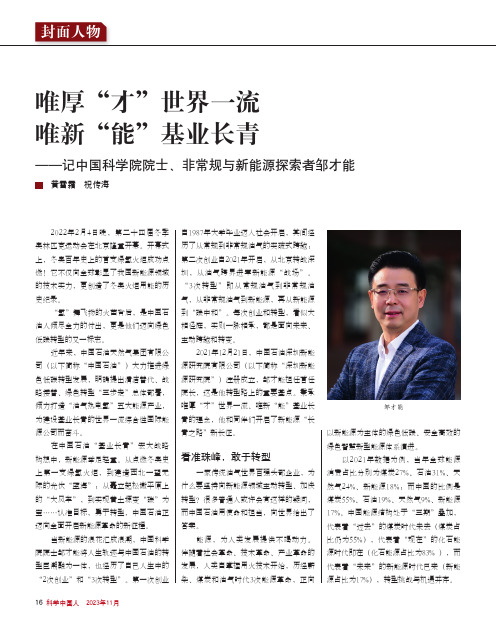
封面人物唯厚“才”世界一流唯新“能”基业长青——记中国科学院院士、非常规与新能源探索者邹才能 黄雪霜 祝传海 2022年2月4日晚,第二十四届冬季奥林匹克运动会在北京隆重开幕。
开幕式上,冬奥百年史上的首支绿氢火炬成功点燃!它不仅向全球彰显了我国新能源领域的技术实力,更创造了冬奥火炬用能的历史纪录。
“氢”舞飞扬的火苗背后,是中国石油人倾尽全力的付出,更是他们迈向绿色低碳转型的又一标志。
近年来,中国石油天然气集团有限公司(以下简称“中国石油”)大力推进绿色低碳转型发展,明确提出清洁替代、战略接替、绿色转型“三步走”总体部署,倾力打造“油气热电氢”五大能源产业,为建设基业长青的世界一流综合性国际能源公司而奋斗。
在中国石油“基业长青”宏大战略构想中,新能源举足轻重。
从点燃冬奥史上第一支绿氢火炬,到建造西北一望无际的光伏“蓝海”;从矗立起松嫩平原上的“大风车”,到实现黄土塬变“碳”为宝……认准目标,勇于转型,中国石油正迈向全面开启新能源革命的新征程。
当新能源的浪花汇成浪潮,中国科学院院士邹才能将人生轨迹与中国石油的转型巨潮融为一体,也经历了自己人生中的“2次创业”和“3次转型”。
第一次创业自1987年大学毕业迈入社会开启,其间经历了从常规到非常规油气的突破式跨越;第二次创业自2021年开启,从北京转战深圳,从油气跨界进军新能源“战场”。
“3次转型”即从常规油气到非常规油气,从非常规油气到新能源,再从新能源到“碳中和”。
每次创业和转型,看似大相径庭,实则一脉相承,都是面向未来、主动跨越和转变。
2021年12月21日,中国石油深圳新能源研究院有限公司(以下简称“深圳新能源研究院”)注册成立,邹才能担任首任院长,这是他转型路上的重要基点。
秉承唯厚“才”世界一流、唯新“能”基业长青的理念,他和同伴们开启了新能源“长青之路”新长征。
看准珠峰,敢于转型一家传统油气世界百强头部企业,为什么要坚持向新能源领域主动转型、加快转型?很多普通人或许会有这样的疑问,而中国石油用使命和担当,向世界给出了答案。
大油气区的内涵_分类_形成和分布_邹才能
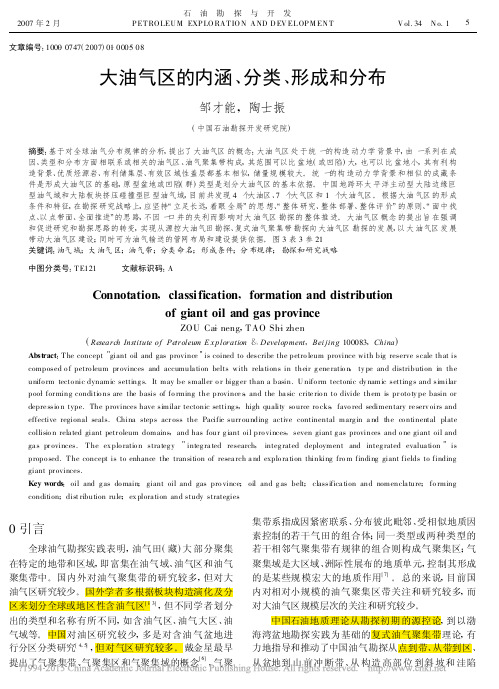
集带系指成因紧密联系 、分布彼此毗邻 、受相似地质因 素控制的若干气田的组合体 ;同一类型或两种类型的 若干相邻气聚集带有规律的组合则构成气聚集区 ;气 聚集域是大区域 、洲际性展布的地质单元 , 控制其形成 的是某些规 模宏大的地质作用[ 7] 。 总的来说 , 目前国 内对相对小规模的油气聚集区带关注和研究较多 , 而 对大油气区规模层次的关注和研究较少 。
作者 Косыгин
年代 1959
Perrodon 1983
K lemme H D 李德生等 朱夏等
1991 1982 1986
戴金星
1991
魏洲龄
1993张恺ຫໍສະໝຸດ 1996陶明信 本文
1998 2006
划分依据 大地构造 相似或可比的 地质背景 全球大地构造 盆地构造类型 原型盆地类型 煤系烃源岩的 区域性分布 现阶段的 动力环境
propo sed. T he concept is to enhance the transition of resea rch a nd explo ra tion thinking fro m finding giant fields to finding
giant pr ovinces. Key words:oil and g as do main;giant oil and gas pro vince ;oil and g as belt ;classifica tion and nomencla ture ;fo rming condition ;dist ribution rule ;ex plora tion and study strategies
笔者建议全球性含油气区使用“油气域” 的名称 , 同一油气域有相近或相似的构造动力学背景 , 具有相 似的油气地质条件 , 其烃源岩 、储集层和区域盖层具有 相似性或可比性 , 根据油气田(藏)分布的板块构造环 境(动力学性质和构造部位)对油气域进行划分和命名 (见图 1 、表 1)。 本文首先将全球规模的含油气区划分 为陆内(间)型油气域和大陆边缘型油气域两大类 , 前 者包括大陆板块挤压型和陆内(间)裂谷型两个巨型油 气域 , 后者包括被动大陆边缘型和主动大陆边缘型两 个巨型油气域 。根据板块构造动 力学性质 , 这些巨型 油气域可分为若干类型 , 如环太平洋主动型大陆边缘 巨型油气域的西侧可分为东亚岛弧 —边缘海油气域和 中国东部陆缘弧后裂谷油气域等 。
2012_邹才能_中国非常规油气勘探与研究新进展

中国非常规油气勘探与研究新进展
邹才能 , 陶士振 , 杨 智, 袁选俊 , 朱如凯 , 侯连华 , 贾进华 , 王 岚, 吴松涛 , 白 斌, 高晓辉 , 杨 春
中国石油勘探开发研究院 , 北京 1 0 0 0 8 3 摘 要: 全球油气勘探目标的转移和石油地质学的发展 , 具有 从 毫 -微 米 孔 喉 的 圈 闭 油 气 , 逐渐向纳米孔喉的连续型油气聚集 发展的趋势 。 近十年非常规油气资源在全球能源格局中的地位愈发重要 , 致密气、 煤层气、 重油、 沥青砂等已成为勘探开发的 重点领域 , 致密油成为亮点领域 , 页岩气成为热点 领 域 。 中 国 致 密 气 、 页 岩 气、 致 密 油、 煤层气等非常规油气资源勘探开发取 油页岩 、 天然气水合物 、 油砂矿等有重要进展 。 中国非常规油气 研 究 也 取 得 重 大 进 展 , 陆相敞流湖盆大型浅水三 得重要突破 , 角洲砂体 、 湖盆中心砂质碎屑流沉积和湖相碳酸盐岩等 , 提供了湖盆中心储集体形成和分布的理论依据; 创新发展了连续型 油气聚集理念 , 明晰了连续型油气聚集的 1 为大面积非常规油气规模勘探开发奠定了理论 0 个基本地质特征和 2 项关键标志 , 系统表征了致密油气储层的纳米级微观孔喉结构 , 首次发现了纳米孔喉中油气的赋存, 推动了纳米孔喉中油气流动机 基础 ; 制和分布规律的研究 。 随着全球石油工业和纳米等技术的快速发展 , 提出了 “ 纳米油气” 概念, 并指出这是未来石油工业的发 展方向 , 需要发展纳米油气透视观测镜 、 纳米油气驱替剂 、 纳米油气开采机器人等换代技术 , 油气智能化时代即将到来 。 关 键 词: 连续型油气聚集 ; 非常规油气 ; 纳米级孔喉 ; 湖盆中心储集体 ; 致密气 ; 致密油 ; 页岩气 ; 纳米油气 ( ) 中图分类号 : T E 1 3 2 . 2 文献标识码 : A 文章编号 : 1 0 0 7 2 8 0 2 2 0 1 2 0 4 0 3 1 2 1 1 - - -
只有枯竭的思想 没有枯竭的能源——记中国科学院院士、非常规油气地质学理论奠基人与能源战略科学家邹才能

只有枯竭的思想没有枯竭的能源——记中国科学院院士、非常规油气地质学理论奠基人与能源战略科学家邹才能作者:祝传海来源:《科学中国人》 2019年第7期近年来,美国引领的页岩气革命对世界能源版图和我国能源战略产生了深远影响。
未来全球能源市场大变革中,各种能源将扮演何种角色?如何加大非常规油气开发,保障我国油气供应安全?如何推动我国能源结构转型,保障能源战略性、长久性安全?这些都是关乎当下国家能源战略制定,以及各类能源产业投资布局的基础性话题。
非常规油气迅猛发展、新能源技术加速迭代,面对这场大能源变革,中国科学院院士、国家能源页岩气研发(实验)中心主任、中国石油勘探开发研究院副院长邹才能教授,作为著名石油天然气地质学家、非常规油气地质学理论奠基人和能源战略研究科学家,对世界能源发展局势进行了研判,并对我国能源结构转型发展提出了针对性建议。
他认为,天然气和新能源将成为中国能源革命的战略性选择。
常规人要有非常规思想2019年3月29日,邹才能受聘中国地质大学(北京)兼职教授,并为学子们带来了一场主题为“能源革命:从化石能源到新能源”的精彩学术报告。
报告伊始,邹才能特别强调:应对非常规“黑天鹅”与新能源“灰犀牛”,是我国能源工作者的使命担当。
报告会上,邹才能认为:“新能源概念是指在新技术基础上加以开发利用,接替传统能源的非化石无碳、可再生清洁能源,主要类型有太阳能、风能、氢能、地热能、海洋能、生物质能、核能、新材料储能等。
与煤炭、石油、天然气等传统含碳化石能源,在理论技术、利用成本、环境影响、管理方式等有显著不同。
”他对当前世界能源发展态势做了分析,目前世界能源一次消费结构形成了煤炭、石油、天然气和新能源“四分天下”的新格局。
相较于美国,中国才刚刚迈入非常规油气时代,正处于常规油气持续发现期和非常规油气战略突破期。
致密油是近期中国非常规石油工业发展的第一重点,致密气和页岩气是非常规气发展的重要部分,页岩油可能成为中国石油接替的战略性领域。
2011.中国油气论坛会议执行程序
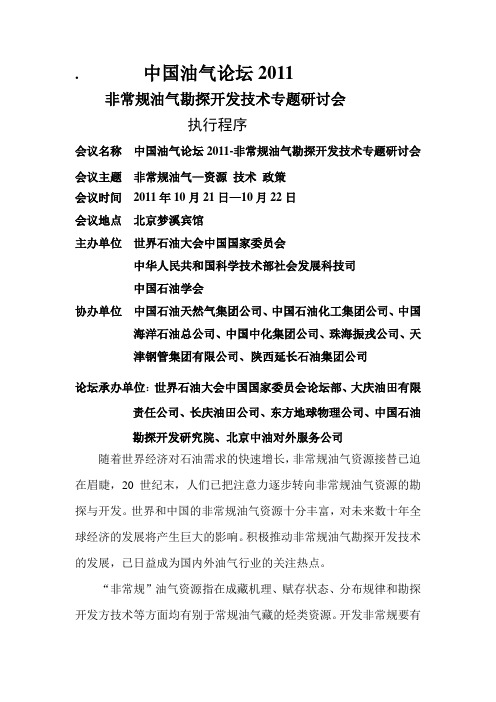
.中国油气论坛2011非常规油气勘探开发技术专题研讨会执行程序会议名称中国油气论坛2011-非常规油气勘探开发技术专题研讨会会议主题非常规油气—资源技术政策会议时间2011年10月21日—10月22日会议地点北京梦溪宾馆主办单位世界石油大会中国国家委员会中华人民共和国科学技术部社会发展科技司中国石油学会协办单位中国石油天然气集团公司、中国石油化工集团公司、中国海洋石油总公司、中国中化集团公司、珠海振戎公司、天津钢管集团有限公司、陕西延长石油集团公司论坛承办单位:世界石油大会中国国家委员会论坛部、大庆油田有限责任公司、长庆油田公司、东方地球物理公司、中国石油勘探开发研究院、北京中油对外服务公司随着世界经济对石油需求的快速增长,非常规油气资源接替已迫在眉睫,20世纪末,人们已把注意力逐步转向非常规油气资源的勘探与开发。
世界和中国的非常规油气资源十分丰富,对未来数十年全球经济的发展将产生巨大的影响。
积极推动非常规油气勘探开发技术的发展,已日益成为国内外油气行业的关注热点。
“非常规”油气资源指在成藏机理、赋存状态、分布规律和勘探开发方技术等方面均有别于常规油气藏的烃类资源。
开发非常规要有新的理念、思路、政策和技术。
本次论坛邀请了国内外著名专家和学者对非常规油气资源、勘探开发技术和政策进行交流和研讨。
交流和研讨的内容包括:致密油,致密气,页岩气,煤层气及天然气水合物,水溶气,油砂,油页岩领域勘探开发技术和相关政策。
中国油气论坛2011-非常规油气勘探开发技术专题研讨会,是一次高层次、高水平的论坛。
世界石油大会中国国家委员会主任王涛博士担任大会主席并致开幕词,中国国家科技部王伟中副部长到会发表讲话,中国石油学会理事长贾承造院士发表讲话并以本次论坛学术委员会主席的名义做主旨报告。
本次论坛的参会人员为中外各大石油公司、有关大专院校、研究单位从事非常规油气勘探开发工作的专家、学者、教授和管理人员。
中方在大会发言的许多专家学者都是这一领域的首席专家、学科带头人。
致密油储集层基本特征

致密油储集层基本特征作者:马荣誉来源:《智富时代》2018年第12期【摘要】近几年来,围绕致密油的界定以及储集条件一直存在较大争议。
在进行大量文献调研后,给出了致密油的基本定义,在实际调研部分致密油储集层特性后,选取其中部分致密油层典型特征以及运移聚集条件予以说明特征围绕。
【关键词】致密油源岩;储集层孔隙结构一、致密油定义致密油是指以吸附或游离状态赋存于生油岩中,或与生油岩互层、紧邻的致密砂岩、致密碳酸盐岩等储集岩中,未经过大规模长距离运移的石油聚集(图1)。
一般来说,致密油具有4个明显的标志:①大面积分布的致密储层(孔隙度2.1 致密油源岩特征充足的油源条件是致密油聚集的前提。
致密油烃源岩有机质丰度高,演化程度较高,生烃潜力较强,分布面积广。
例如,四川盆地侏罗系致密油有效烃源岩展布面积为10.0×104km2,厚度为40~240m,TOC值为0.8%~3.0%,生烃潜量为6.59~7.24mg/g,RO值介于0.9%~1.4%之间,生烃强度较高[4]。
这些烃源岩在一定条件下能生成大量的油气,与储层产生较大的压力差,为致密油聚集提供良好的物质条件与动力条件。
2.2致密油储层特征储层岩性与物性致密油储层岩性一般为粉细砂岩,其中鄂尔多斯盆地延长组致密油有效储层主要为粉细砂岩,Bakken组致密油有效储层主要为白云质粉砂岩和粉砂岩。
2.3致密油宏观聚集条件国内外学者研究表明,致密油主要聚集条件为大面积分布的优质烃源岩与致密储层在空间上紧密接触。
这种聚集条件可归纳为3个方面:①广覆式分布的优质烃源岩层;②大面积分布的致密储集层;③连续型分布的致密储集层与烃源岩紧密接触的共生层系。
2.4储层孔隙结构目前对于致密砂岩储层微观孔隙结构的研究主要集中在储层微观孔隙结构的表征以及微观孔隙结构与储层宏观性质如渗透率等之间的关系等方面的研究;并探讨了成岩作用对微观孔隙结构的控制,除了压实、胶结等减孔作用和溶蚀等增孔效应外,黏土矿物以及微晶石英对孔隙结构的作用也有较多研究。
“斜杠”院士邹才能

奋斗者Pioneers“斜杠”院士邹才能邹才能中科院院士、中国石油勘探开发研究院副院长作为中国石油勘探开发研究院副院长,也是我国石油地质研究和油气勘探的领军人物,他经常被调侃是“被能源耽误的功夫巨星”。
中科院院士邹才能出的第一本书是民间武术秘笈《秘传·6步夺命功》。
作为中国石油勘探开发研究院副院长,也是我国石油地质研究和油气勘探的领军人物,他经常被调侃是“被能源耽误的功夫巨星”。
“常规人要有非常规思想,也就是创新的思想。
”这是邹才能常说的一句话。
他是我国非常规油气地质学理论的创建人,首个发现北美以外更古老的页岩气层系和具工业价值的纳米孔隙,提出常规—非常规油气“有序聚集、协同发展”,推动了我国油气勘探战略转变。
但油气勘探和能源研究都没有让他放下自己的业余爱好,练武术、办摄影展……他的“斜杠”生活忙碌而充满乐趣。
勘探非常规油气“我的专业就是在世界上找油找气。
”谈到自己的研究领域,邹才能喜欢用大白话,“找到在地下一公里或10公里哪个地方有油有气就是我们的专业。
”他至今还记得母校西南石油大学的校训:为祖国加油,为民族争气。
毕业30多年来,他一直在为这句话奋斗。
煤炭、石油、天然气都是不可再生能源,它们的枯竭成为能源界的共同忧虑。
据预测,到目前为止,全球已经找到的煤炭还可以利用130年,找到的石油还可以利用50年,找到的天然气还可以用50年。
邹才能认为我们还可以找油找气。
石油工□ 《民生周刊》记者 罗燕64民生周刊2019.08.26业走过了160年的历史,主要是常规油气藏开发。
但非常规油气有巨量的资源,是常规油气的8倍。
“只有解放不了的思想,没有解放不了的油气。
常规的思想,找不到非常规油气,常规的技术也拿不出非常规油气。
”邹才能说。
他带领团队进行深入研究,揭示了非常规油气“连续型”聚集规律,提出“人造油气藏”开发的新概念。
据他介绍,常规油气藏可称为“圈闭油气藏”,是一种天然油气藏,圈闭界限很明显,有统一油、气、水界面,有自然渗透率,一般采用直井开采,不需要人工压裂改造即可形成工业油气产量。
页岩油形成机制_地质特征及发展对策
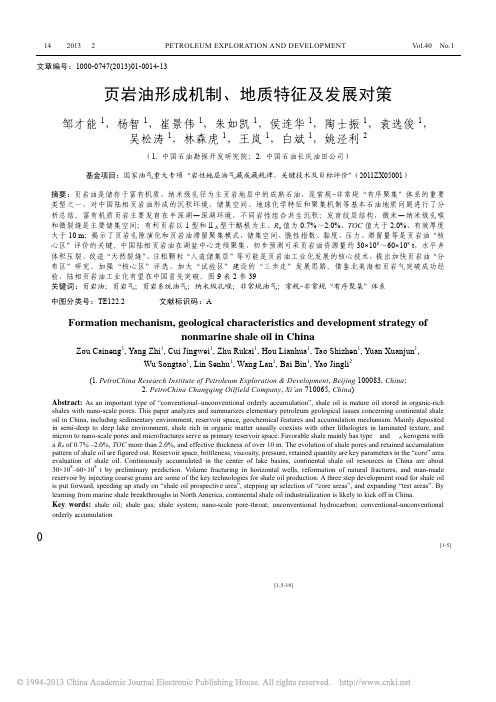
量、需采用新技术改善储集层渗透性或流体流动性等 才能经济开采、连续或准连续型聚集的油气资源。常 规与非常规油气聚集的本质区别是油气是否明显受圈 闭控制、单井是否有自然工业产能。非常规油气有两 个关键标志: ① 油气大面积连续或准连续分布,圈闭 界限不明显;②无自然工业稳定产能,达西渗流不 明显。 常规 -非常规油气“有序聚集”体系,是指富油气 盆地或凹陷内常规与非常规油气在时间域持续充注、 空间域有序分布,二者成因有先后、相互依存、紧密 共生,形成统一的油气聚集体系。该体系揭示出不同 类型油气资源“有序聚集”的规律,展示出富油气盆 地或凹陷内常规与非常规油气资源应“同步研究、同 步部署、同步勘探” ,可采用平台式多井“大井场”开 采模式对不同层系、不同类型油气“同步开发” ,加快 勘探开发节奏,提高资源利用效率和经济效益。据此 规律可透视不同类型油气在空间上的分布位置,一般 发现常规油气,预示供烃方向可能有非常规油气分布; 发现非常规油气,预示外围空间可能有常规油气伴生。 平面上,一般盆地边缘或斜坡分布常规构造油气藏和 岩性地层油气藏,凹陷或沉积中心聚集非常规致密油 气和页岩油气等;纵向上,从浅到深分布远源的常规 油气藏、近源的致密油气和源内的页岩油气。以往不 同阶段找油气思路有差异,一般早中期立足常规油气 资源,用“源控论”寻找大型构造油气藏、 “复式油气 聚集带”或“大油气区”理论寻找构造与岩性地层油 气藏集群;中后期立足非常规油气资源,用“连续型 油气聚集”认识,寻找近源致密油气或源内页岩油气。 而常规 -非常规油气“有序聚集”体系认识突破了传统 找油气思路,推动找油气地质理论从“找点” 、 “找带” 、 “找面”向“找体”跨越,打破先找常规后找非常规 “先富后贫”的找油思路。对待常规与非常规油气, 勘探追求“一网打尽” ,开发追求“吃干榨尽” 。 非常规油气主要类型是页岩系统油气,包括致密 油和气、页岩油和气。页岩气的成功开发利用突破了 页岩气开采的理论关、技术关、成本关和环保关“四 道关口” ,已成为全球非常规天然气勘探开发热点[1,4-5]。 页岩气是非常规天然气的成功革命者,页岩油可能成 为非常规石油的革命者。 目前全球已在阿巴拉契亚、墨西哥湾、西西伯利 亚、松辽等盆地发现了泥页岩裂缝型油气,特殊泥页 但在基质页岩油能否形成工业 岩裂缝出油已成共识 [6], 化聚集和经济性开采问题上,理论界和工业界主要持 否定和悲观态度,也尚未有取得工业突破的报道。以 往研究认为富有机质黑色页岩主要是提供油气来源的
非常规油气突破引发世界石油工业科技新革命——访中国石油勘探开发研究院副院长兼总地质师邹才能博士

非常规油气突破引发世界石油工业科技新革命——访中国石油勘探开发研究院副院长兼总地质师邹才能博士作者:王大锐来源:《石油知识》 2013年第5期本刊特约记者王大锐美国“页岩气革命”推动全球非常规油气获得战略性突破,挑战了传统石油地质学和传统工业化技术方法,石油工业进入了新的科技创新机遇期。
邹才能博士及其团队针对非常规油气开展了一系列科技攻关工作,在连续型油气聚集理论、致密储层纳米级孔隙系统发现、非常规资源潜力评价、不同类型非常规油气发展策略、非常规基础研究与实验评价方法创新、非常规油气地质学发展与人才培养等都取得重要成果。
我专访了我国非常规油气地质学的倡导者和先行者邹才能教授。
问:邹院长好,最近几年在美国“页岩气革命”推动下,全球掀起了非常规油气发展热潮,请您给我们介绍一下,究竟什么是非常规油气?答:目前不同学者对非常规油气描述与理解不尽相同,一般认为非常规油气是指在现有经济技术条件下,不能用传统技术开发的油气资源。
石油工程师学会(SPE)、美国石油地质师协会(AAPG)、石油评价工程师学会(SPEE)、世界石油大会(WPC)2007年联合发布非常规资源的定义:非常规资源存在于大面积遍布的石油聚集中,不受水动力效应的明显影响,也称为“连续型沉积矿”;认为非常规油气资源与连续型油气概念一致。
我们在系统分析各类非常规油气基本特征的基础上,从更严格和科学的角度,重新厘定涵盖目前主要观点的非常规油气概念:非常规油气是指用传统技术无法获得自然工业产量、需用新技术改善储集层渗透率或流体黏度等才能经济开采、连续或准连续型聚集的油气资源。
有两个关键标志和两个关键参数,两个关键标志为:油气大面积连续分布,圈闭界限不明显;无自然工业稳定产量,达西渗流不明显。
两个关键参数为:孔隙度一般小于10%;孔喉直径一般小于1μm或渗透率小于1×103μm2。
问:非常规油气都包括哪些类型?还有哪些特征?答:非常规油气类型多样,主要包括页岩油和气、致密油和气、重油、油砂油、油页岩油、煤层气、天然气水合物等。
常规_非常规油气_有序聚集_理论认识及实践意义_邹才能
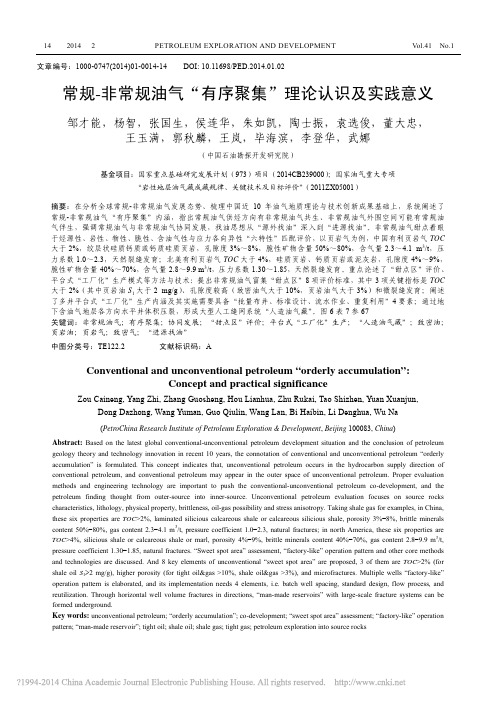
石油勘探与开发14 2014年2月PETROLEUM EXPLORATION AND DEVELOPMENT Vol.41 No.1 文章编号:1000-0747(2014)01-0014-14 DOI: 10.11698/PED.2014.01.02常规-非常规油气“有序聚集”理论认识及实践意义邹才能,杨智,张国生,侯连华,朱如凯,陶士振,袁选俊,董大忠,王玉满,郭秋麟,王岚,毕海滨,李登华,武娜(中国石油勘探开发研究院)基金项目:国家重点基础研究发展计划(973)项目(2014CB239000);国家油气重大专项“岩性地层油气藏成藏规律、关键技术及目标评价”(2011ZX05001)摘要:在分析全球常规-非常规油气发展态势、梳理中国近10年油气地质理论与技术创新成果基础上,系统阐述了常规-非常规油气“有序聚集”内涵,指出常规油气供烃方向有非常规油气共生、非常规油气外围空间可能有常规油气伴生,强调常规油气与非常规油气协同发展,找油思想从“源外找油”深入到“进源找油”。
非常规油气甜点着眼于烃源性、岩性、物性、脆性、含油气性与应力各向异性“六特性”匹配评价,以页岩气为例,中国有利页岩气TOC 大于2%,纹层状硅质钙质或钙质硅质页岩,孔隙度3%~8%,脆性矿物含量50%~80%,含气量2.3~4.1 m3/t,压力系数1.0~2.3,天然裂缝发育;北美有利页岩气TOC大于4%,硅质页岩、钙质页岩或泥灰岩,孔隙度4%~9%,脆性矿物含量40%~70%,含气量2.8~9.9 m3/t,压力系数1.30~1.85,天然裂缝发育。
重点论述了“甜点区”评价、平台式“工厂化”生产模式等方法与技术:提出非常规油气富集“甜点区”8项评价标准,其中3项关键指标是TOC 大于2%(其中页岩油S1大于2 mg/g)、孔隙度较高(致密油气大于10%,页岩油气大于3%)和微裂缝发育;阐述了多井平台式“工厂化”生产内涵及其实施需要具备“批量布井、标准设计、流水作业、重复利用”4要素;通过地下含油气地层各方向水平井体积压裂,形成大型人工缝网系统“人造油气藏”。
我国天然气发展成就和前景展望——访中国科学院院士邹才能

我国天然气发展成就和前景展望——访中国科学院院士邹才能作者:王大锐来源:《石油知识》 2018年第4期王大锐世界能源从固态(木柴 + 煤炭)、液态(石油)向气态(天然气)转变。
化石能源低碳化、新能源规模化、能源系统智能化正在成为能源工业发展的新趋势。
应对气候变化,加快推进能源的低碳化转型已成全球共识,主要途径是控制与降低化石能源的碳排放量,并大力发展可再生能源等非化石能源。
为了解更多的常规—非常规天然气的研究成果,我采访新当选的中国科学院院院士、中国石油勘探开发研究院副院长邹才能教授。
问:邹院士,请介绍一下目前国内外天然气发展的现状。
答:好的。
全球天然气资源丰富,具备长期加快发展的资源基础。
至2016年底,全球累计探明天然气可采储量296万亿立方米,累计采出天然气约110万亿立方米,采出比例37%;剩余探明可采储量186万亿立方米,年产量3.55万亿立方米,储采比52.4。
全球常规天然气勘探潜力依然可观,可采资源量近470万亿立方米,至2016年累计探明常规天然气可采储量280万亿立方米,仍有40%的常规天然气资源量未探明。
非常规天然气发展潜力很大,全球致密气、煤层气和页岩气三类非常规天然气可采资源量约920万亿立方米,再加上天然气水合物的2000~3000万亿立方米,至少是常规天然气的8倍以上。
至2016年底,不包括水合物,非常规天然气累积探明可采储量约16万亿立方米,探明率不足1%,累积采出量约7.7万亿立方米。
中国近70年天然气发展历程,主要是上游发展驱动产业进程,历经三个阶段的跨越式发展。
首先是发展起步期(1949-1975年),天然气年产量从1000万立方米增长到100亿立方米,四川盆地多个小型气田是产量主体,初步建成川渝输气管网,四川盆地是中国天然气工业的发源地。
其次是缓慢增长期(1976-2000年),天然气年产量从100亿立方米增长到300亿立方米,油气工业呈现“重油轻气”特点,发现了一些小型气田,油田伴生气(溶解气)产量增加,占总产量的40%。
中国油气储层中纳米孔首次发现及其科学价值_邹才能

Zou CN,Zhu RK,Bai B,Yang Z,Wu ST,Su L,Dong DZ and Li XJ. 2011. First discovery of nanopore throat in oil and gas reservoir in China and its scientific value. Acta Petrologica Sinica, 27 ( 6 ) :1857 - 1864 Abstract The oil and gas reservoirs have been divided in three types: Millimeterpore,micropore and nanopore. The diameter of pore throat in conventional reservoir is generally larger than one micron. The diameter of nanopore in shale gas reservoirs ranges between 5 and 160 nanometers in North American,mainly from 80 to 100 nanometers. Based on the field emission SEM and the nano pore in research of unconventional tight sandstone and shale gas CT reconfiguration technique,it was the first discovery of nanopore in tight sandstone gas reservoirs is mainly of grain reservoir in China,whose diameter is less than one micron. The nanomicropore,authigenic mineral intragranular pore and microfracture,throat is sheetlike,bended platy,has poor connectivity and its diameter ranges between 10 and 1000 nanometers,mainly from 300 to 900 nanometers. The nanopore in shale gas reservoirs is mainly of organic matter nanopore,grain nanopore and authigenic mineral intragranular pore,and its diameter ranges between 5 and 300 nanometers,mainly from 80 to 200 nanometers. The nanopore is main body of connectivitive reservoir space in tight reservoirs. The discovery of nanopore system within oil and gas reservoir has changed the traditional understanding that the micronpore is exclusive. It also provided the significant scientific value with understanding geological characteristics of conventional oil and gas local accumulation, unconventionally continuous petroleum accumulation, develop petroleum accumulation mechanism and increase the potential of resources. Key words Nanopore; Unconventional petroleum; Shale gas; Tight sandstone gas,Nano petroleum; Continuous petroleum accumulation 摘 要 油气储层孔隙可分为毫米级孔 、 微米级孔、 纳米级孔 3 种类型, 常规储层孔隙直径一般大于 1 μm。 北美地区页岩
中国致密油形成分布与资源潜力评价

1 前言
致密油是致密储层油的简称,赋存于致密砂岩 或致密灰岩等储层中[1]。近年来,随着北美致密油 的大规模成功开采,此类以往被忽视的非常规石油 资源已经成为各国石油工业争相介入的热点领域。 目前,北美 是 致 密 油 资 源 开 发 最 多 和 最 成 功 的 地 区[2]。在我国,致 密 油 资 源 潜 力 也 很 大,分 布 范 围 广,重点包括鄂尔多斯盆地延长组致密砂岩、四川盆 地侏罗系、渤海湾盆地沙河街湖相碳酸盐岩、酒泉盆 地白垩系 泥 灰 岩、准 噶 尔 盆 地 二 叠 系 云 质 岩 等[1]。 致密油的形成分布和常规石油资源相比具有差异 性,其油 气 聚 集 的 场 所 已 突 破 圈 闭 概 念[3]。 因 此, 一些基于常规石油的石油地质学认识在解释致密油 的形成和分布特征时已不适用。为此,笔者等分析 了国外典型致密油区的共性特征,并以此为指导对 我国致密油的形成分布与资源潜力进行评价。
2 全球致密油勘探与研究进展
2. 1 国外致密油勘探进展 自北美 Bakken 地区借鉴页岩气技术成功开辟
致密油新领域之后,致密油已成为北美页岩气之后 的又一战略性突破领域。经过不断研究,目前已探 明并开发了规模可观的致密油,取得巨大勘探进展。
石油工业界的非常规才能——专访中国石油勘探开发研究院副院长邹才能教授

石 油 地 质 专 业 委 员会 油 气沉 积 储 层 学 组 组 长 ,中 国石 油 学会 天 然 气 专 业 委 员会 非 常规 天 然 气学 组 组 长 ; 《 石 油勘 探 与开 发》 、 《 石 油 学报 》 、 《 天 然 气地 球 科 学》 杂 志 编 委 ; 北 京 大 学 、 长江 大 学 、 西安 石 油 大 学 兼 职教 授 。 长期 从 事 非 常 规 油 气、 岩 性 地 层 油 气 藏 、 大 油 气 区等 地 质 理 论 创 新 研 究 ,以 及 我 国 重 大 预 探 领 域 、科 探 井 与风 险 井 、勘 探 技 术 方 法 等 攻
世界油 气工业正在进 行新的一次解放思 想和科技革 命 ,我们必须 从战略上做好
理论技术创新和超前储备 ”。 认识 的误 区就是勘探 的禁区。 邹才能教授说 , “ 常规思想 找不到非常
规 油 气 .常规 技 术 拿 不 到 非 常 规 油 气 。 找 油 要 不 断 重 新 认 识 找 油 理 论 、 不 断 重 新 认 识 找 油 技 术 、不 断 重 新 认 识 找 油 思
随着 非 常规 连续 型 油气 聚 集理 论 、水 平井 多级 压 裂
技术、平台式工厂化生产模式的突破 .美国页岩气率先实 现了快速发展 成为了非常规天然气发展的热点方向 同
时 ,致 密油成 为非常规石油发展 的亮点 类型。全球传统 能
源格局再 度重塑 ,形 成 以中东 为核心的东 半球 常规 油气 版图 ” .及 以美洲 为核心 的西 半球 “ 非 常规 油气版 图”。
致密油气才是当红主角
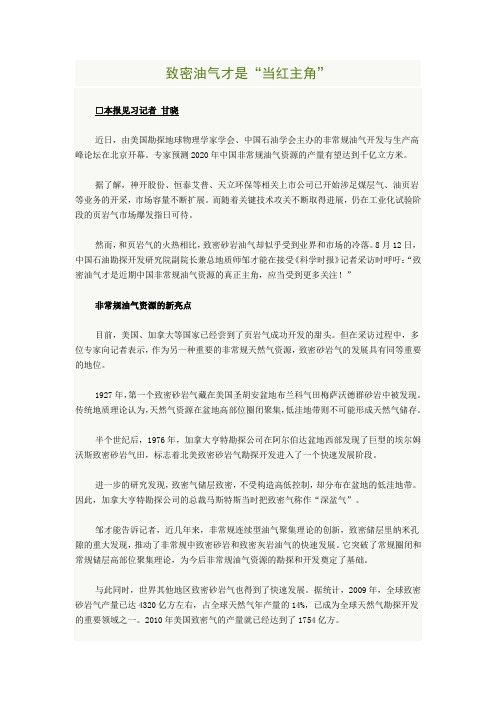
致密油气才是“当红主角”□本报见习记者甘晓近日,由美国勘探地球物理学家学会、中国石油学会主办的非常规油气开发与生产高峰论坛在北京开幕。
专家预测2020年中国非常规油气资源的产量有望达到千亿立方米。
据了解,神开股份、恒泰艾普、天立环保等相关上市公司已开始涉足煤层气、油页岩等业务的开采,市场容量不断扩展。
而随着关键技术攻关不断取得进展,仍在工业化试验阶段的页岩气市场爆发指日可待。
然而,和页岩气的火热相比,致密砂岩油气却似乎受到业界和市场的冷落。
8月12日,中国石油勘探开发研究院副院长兼总地质师邹才能在接受《科学时报》记者采访时呼吁:“致密油气才是近期中国非常规油气资源的真正主角,应当受到更多关注!”非常规油气资源的新亮点目前,美国、加拿大等国家已经尝到了页岩气成功开发的甜头。
但在采访过程中,多位专家向记者表示,作为另一种重要的非常规天然气资源,致密砂岩气的发展具有同等重要的地位。
1927年,第一个致密砂岩气藏在美国圣胡安盆地布兰科气田梅萨沃德群砂岩中被发现。
传统地质理论认为,天然气资源在盆地高部位圈闭聚集,低洼地带则不可能形成天然气储存。
半个世纪后,1976年,加拿大亨特勘探公司在阿尔伯达盆地西部发现了巨型的埃尔姆沃斯致密砂岩气田,标志着北美致密砂岩气勘探开发进入了一个快速发展阶段。
进一步的研究发现,致密气储层致密,不受构造高低控制,却分布在盆地的低洼地带。
因此,加拿大亨特勘探公司的总裁马斯特斯当时把致密气称作“深盆气”。
邹才能告诉记者,近几年来,非常规连续型油气聚集理论的创新,致密储层里纳米孔隙的重大发现,推动了非常规中致密砂岩和致密灰岩油气的快速发展。
它突破了常规圈闭和常规储层高部位聚集理论,为今后非常规油气资源的勘探和开发奠定了基础。
与此同时,世界其他地区致密砂岩气也得到了快速发展。
据统计,2009年,全球致密砂岩气产量已达4320亿方左右,占全球天然气年产量的14%,已成为全球天然气勘探开发的重要领域之一。
邹才能的“非常规”路
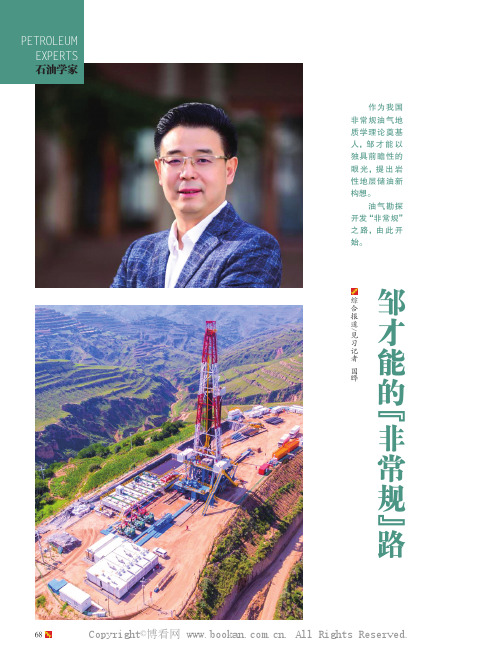
作为我国非常规油气地质学理论奠基人,邹才能以独具前瞻性的眼光,提出岩性地层储油新构想。
油气勘探开发“非常规”之路,由此开始。
合报道/见习记者国晔石油学家PETROLEUM EXPERTS邹才能的“非常规”路首创了“人工油气藏”开发概念,第一个发现北美以外更古老的页岩气层系和具工业价值的纳米孔隙;论证了岩性地层油气成藏机理,建立湖盆中心砂质碎屑流等沉积模式;阐明了古老碳酸盐岩大气田形成分布规律,构建“四古”成藏模式;提出了“氢能中国”、中国“能源独立”等战略构想……他就是中科院院士邹才能。
开拓岩砂储层新领域21世纪初,我国陆上构造油气藏勘探难度逐渐加大,找到的构造越来越小,特别是东部盆地,只有几个平方公里或零点几个平方公里。
过去的找油理论,已不能完全适应现实需要,“常规油”的勘探开发陷入瓶颈。
石油地质与构造地质学家贾承造院士曾提出,要改变思路,找岩性地层油气藏。
找油,从构造圈闭向岩性地层转变,有很多的理论和基础性工作需要重新来做。
其中一个核心问题就是:湖盆中心是否有发育优质的储层?在查阅大量资料后,邹才能发现国外建立了海相深水砂质碎屑流沉积模式,但对陆相湖盆中心是否有砂岩的关注很少。
经过仔细分析研究后,他创新地提出了“在湖盆里面,找到砂岩就能找到储层,找到储层就能找到油”。
湖盆中心砂质碎屑流沉积模式。
观点一经提出,各种质疑纷沓至来。
对此,邹才能并没有停止相关研究。
他认为,新观点往往伴随着争议,关键在于敢不敢坚持下去。
只有坚持下来,才有可能取得突破。
于是,邹才能不断向院士、专家们请教,并带领团队开始进行大量的勘探实践,最终证明了观点的正确性。
以此为基础,邹才能建立起湖盆中心砂质碎屑流沉积模式,为鄂尔多斯盆地发现10亿吨级岩性大油田,提供了理论和技术支撑。
2007年,邹才能的中低丰度岩性地层油气藏大面积成藏地质理论、勘探技术及重大发现,获得了国家科技进步一等奖。
发现纳米孔中大世界将纳米技术与油气领域全面结合,提出“纳米油气”全新概念并付诸实践,这是邹才能带领团队完成的一项创举。
纳米技术助力非常规油气开发

纳米技术助力非常规油气开发
日前,国土资源部召开新闻发布会,公布2013 年我国非常规天然气煤层气和页岩气产量分别超过30 亿立方米和2 亿立方米,其中页岩气产量已超过200 万立方米/天。
预计到2030 年,非常规油气开发将占油气总产量的1/3。
中国科学院大学地球科学学院教授琚宜文表示:利用纳米科学理论与技术方法对我国非常规油气的形成、运移、聚集和开采进行创新性研究,将推动我国非常规油气产业的快速发展,增加国家能源战略储备。
纳米孔隙中寻找油气
传统石油地质理论认为,毫米和微米级的裂隙、溶隙与孔隙系统是油气储层中的主要储集空间和渗流通道。
而在极低渗透性的致密砂岩、煤层和页岩等非常规储层中,如何开采出有经济效益的油气,是困扰非常规油气发展的关键问题。
纳米孔隙结构是煤层气和页岩气的主要吸附空间。
琚宜文介绍。
他带领的科研团队曾于2003 年运用X 射线衍射、液氮吸附等方法对煤岩大分子结构和纳米级孔隙进行了系统研究,认清了煤岩结构与甲烷吸附和解吸作用的关系。
2007 年,美国地质学者获取了福特沃斯盆地巴奈特页岩有机质纳米孔隙中国石油勘探开发研究院副院长邹才能介绍:我国页岩气储层孔隙直径为5200 纳米。
2010 年,他领导的研究团队在我国第一口页岩气井中,首次直观获取了我国页岩气储层的纳米级孔此外,邹才能团队的研究还揭示了致密油气储层纳米孔隙的大小。
致密灰岩油、砂岩油、砂岩气储层孔隙直径分别为40-500 纳米、50-900 纳米、40-700 纳米。
邹才能说。
纳米技术助力非常规油气开发。
论常规—非常规油气有序“共生富集”——兼论常规—非常规油气地质学理论技术
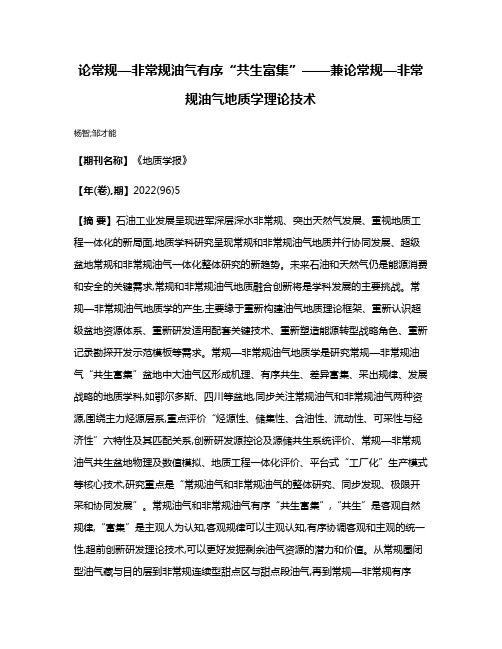
论常规—非常规油气有序“共生富集”——兼论常规—非常规油气地质学理论技术杨智;邹才能【期刊名称】《地质学报》【年(卷),期】2022(96)5【摘要】石油工业发展呈现进军深层深水非常规、突出天然气发展、重视地质工程一体化的新局面,地质学科研究呈现常规和非常规油气地质并行协同发展、超级盆地常规和非常规油气一体化整体研究的新趋势。
未来石油和天然气仍是能源消费和安全的关键需求,常规和非常规油气地质融合创新将是学科发展的主要挑战。
常规—非常规油气地质学的产生,主要缘于重新构建油气地质理论框架、重新认识超级盆地资源体系、重新研发适用配套关键技术、重新塑造能源转型战略角色、重新记录勘探开发示范模板等需求。
常规—非常规油气地质学是研究常规—非常规油气“共生富集”盆地中大油气区形成机理、有序共生、差异富集、采出规律、发展战略的地质学科,如鄂尔多斯、四川等盆地,同步关注常规油气和非常规油气两种资源,围绕主力烃源层系,重点评价“烃源性、储集性、含油性、流动性、可采性与经济性”六特性及其匹配关系,创新研发源控论及源储共生系统评价、常规—非常规油气共生盆地物理及数值模拟、地质工程一体化评价、平台式“工厂化”生产模式等核心技术,研究重点是“常规油气和非常规油气的整体研究、同步发现、极限开采和协同发展”。
常规油气和非常规油气有序“共生富集”,“共生”是客观自然规律,“富集”是主观人为认知,客观规律可以主观认知,有序协调客观和主观的统一性,超前创新研发理论技术,可以更好发掘剩余油气资源的潜力和价值。
从常规圈闭型油气藏与目的层到非常规连续型甜点区与甜点段油气,再到常规—非常规有序“共生富集”油气,理论认识和核心技术的创新发展,将引领和支撑油气资源不断实现高效发现和利用。
【总页数】19页(P1635-1653)【作者】杨智;邹才能【作者单位】中国石油勘探开发研究院【正文语种】中文【中图分类】P61【相关文献】1.非常规油气概念、特征、潜力及技术——兼论非常规油气地质学2.非常规油气地质研究发展与技术需求r——访中国石油大学(北京)非常规天然气研究院院长宋岩教授3.为非常规油气藏打造钻完井利器--记石油工程公司非常规油气藏钻完井技术攻关创新团队4.准噶尔盆地玛湖凹陷风城组常规-非常规油气有序共生与全油气系统成藏模式5.非常规油气将成常规油气重要接替非常规气与常规天然气可采资源量相当因版权原因,仅展示原文概要,查看原文内容请购买。
非常规油气突破源于三大科技创新
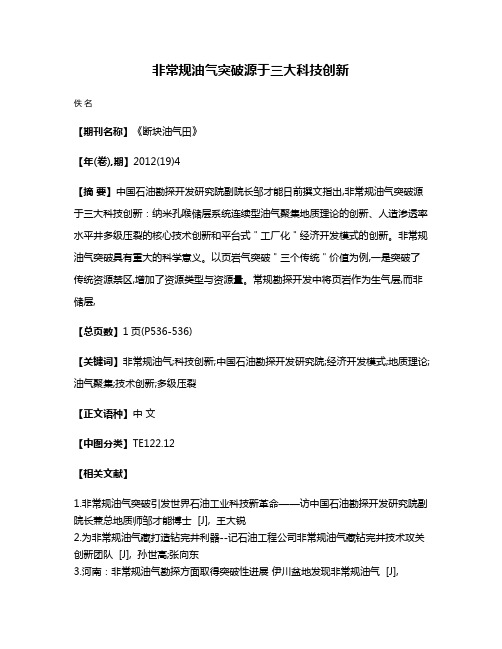
非常规油气突破源于三大科技创新
佚名
【期刊名称】《断块油气田》
【年(卷),期】2012(19)4
【摘要】中国石油勘探开发研究院副院长邹才能日前撰文指出,非常规油气突破源于三大科技创新:纳米孔喉储层系统连续型油气聚集地质理论的创新、人造渗透率水平井多级压裂的核心技术创新和平台式"工厂化"经济开发模式的创新。
非常规油气突破具有重大的科学意义。
以页岩气突破"三个传统"价值为例,一是突破了传统资源禁区,增加了资源类型与资源量。
常规勘探开发中将页岩作为生气层,而非储层,
【总页数】1页(P536-536)
【关键词】非常规油气;科技创新;中国石油勘探开发研究院;经济开发模式;地质理论;油气聚集;技术创新;多级压裂
【正文语种】中文
【中图分类】TE122.12
【相关文献】
1.非常规油气突破引发世界石油工业科技新革命——访中国石油勘探开发研究院副院长兼总地质师邹才能博士 [J], 王大锐
2.为非常规油气藏打造钻完井利器--记石油工程公司非常规油气藏钻完井技术攻关创新团队 [J], 孙世高;张向东
3.河南:非常规油气勘探方面取得突破性进展伊川盆地发现非常规油气 [J],
4.创新理论提升实践实现非常规油气技术的突破——《非常规油气》发刊词 [J], 戴金星;
5.传统油气地质理论的突破与创新及非常规油气资源潜力 [J], 苗钱友;朱筱敏;姜振学;李卓;陈磊;张昆;原园
因版权原因,仅展示原文概要,查看原文内容请购买。
- 1、下载文档前请自行甄别文档内容的完整性,平台不提供额外的编辑、内容补充、找答案等附加服务。
- 2、"仅部分预览"的文档,不可在线预览部分如存在完整性等问题,可反馈申请退款(可完整预览的文档不适用该条件!)。
- 3、如文档侵犯您的权益,请联系客服反馈,我们会尽快为您处理(人工客服工作时间:9:00-18:30)。
石油勘探与开发2012年2月PETROLEUM EXPLORATION AND DEVELOPMENT Vol.39 No.1 13 文章编号:1000-0747(2012)01-0013-14纳米油气与源储共生型油气聚集邹才能,杨智,陶士振,李伟,吴松涛,侯连华,朱如凯,袁选俊,王岚,高晓辉,贾进华,郭秋麟,白斌(中国石油勘探开发研究院)基金项目:国家大型油气田与煤层气开发项目(2011ZX05001)摘要:在对比非常规油气与常规油气类型、地质特征及勘探技术的基础上,提出“纳米油气”的概念,指出“纳米油气”是未来石油工业的发展方向。
纳米油气是指用纳米技术研究和开采聚集在纳米级孔喉储集系统中的油气,纳米油气主要分布在烃源岩层及与其大面积紧密接触的近源致密储集层系中,涵盖了页岩油、页岩气、煤层气、致密砂岩油、致密砂岩气、致密灰岩油等,储集层孔喉直径一般为纳米级;油气水在纳米孔喉中渗流能力差,相态分异难,主要依靠超压驱动,油气被滞留吸附,在源储共生致密层系中大面积连续分布。
中国含油气盆地发育源储共生型致密层系、碳酸盐岩缝洞层系、火山岩缝洞层系、变质岩裂缝层系等多种类型油气聚集层系,其中源储共生层系油气聚集位于盆地中心或斜坡部位,源内或近源层状大面积聚集,是资源分布的主体和未来发展重点领域。
以鄂尔多斯盆地和四川盆地源储共生型油气聚集为典型实例,提出连续型油气“两线一区”(即源储共生层系油气聚集顶底界线、油气连续聚集边界线、“甜点”分布核心区)评价方法。
图10表9参32关键词:纳米油气;纳米技术;源储共生致密油气;非常规油气;致密油;致密气;页岩气;页岩油;连续型油气聚集中图分类号:TE122 文献标识码:ANano-hydrocarbon and the accumulation in coexistingsource and reservoirZou Caineng, Yang Zhi, Tao Shizhen, Li Wei, Wu Songtao, Hou Lianhua, Zhu Rukai, Yuan Xuanjun,Wang Lan, Gao Xiaohui, Jia Jinhua, Guo Qiulin, Bai Bin(PetroChina Research Institute of Petroleum Exploration & Development, Beijing 100083, China)Abstract:By comparison of the types, geological characteristics and exploration technologies of conventional and unconventional hydrocarbon, this paper proposes the concept of “nano-hydrocarbon” and indicates that “nano-hydrocarbon” is the development direction of oil and gas industry in the future. Nano-hydrocarbon refers to the research and production, by nano-technology, of oil and gas accumulated in the reservoir system of nano-sized pore-throats. It is mainly distributed in source rocks and the neighbouring tight reservoirs and includes shale oil, shale gas, coal-bed methane, tight sandstone oil & gas, tight limestone oil and so on, with nano-sized diameter of pore-throats in reservoirs. Oil, gas and water in nano-sized pore-throats exhibit poor percolation and phase separation, and are mainly driven by ultra-pressure, thus existing pervasively and continuously in the coexisting tight strata of source and reservoir. China’s petroliferous basins develop multiple series such as coexisting tight source and reservoir, carbonate fractures and cavities, volcanic fractures and cavities, and metamorphic rock fractures. Of them, the first type of series is located in the center or along the slopes of the basins, are accumulated extensively within or near sources and are dominant potential sources. With accumulations within coexisting source and reservoir in the Ordos Basin and Sichuan Basin as examples, the method of “two lines and one area” to prospect continuous-type hydrocarbon accumulation is proposed, i.e. the top and bottom boundaries of a set of coexisting source and reservoir and the boundaries of hydrocarbon accumulation as lines, and “sweet spot” distributing core area as main exploration target.Key words:nano-hydrocarbon; nano-technology; tight hydrocarbon within coexisting source and reservoir; unconventional hydrocarbon;tight oil; tight gas; shale gas; shale oil; continuous hydrocarbon accumulation0 引言石油地质学和全球油气勘探目标具有从毫米—微米孔喉的圈闭油气领域逐渐向纳米孔喉的源储共生连续型油气聚集新领域发展的趋势。
从最初19世纪50 年代的利用油气苗找油,到19世纪80年代的背斜理论[1-2]、20世纪20年代的圈闭理论[1-2],再到20世纪40—50年代的干酪根晚期热降解生烃及陆相生油理论[3-5],20世纪60—80年代的陆相盆地“定凹选带”源控论[6]、复式油气聚集带理论[7-9]及煤成气理论[10-11],20世纪90年代“从源岩到圈闭”的含油气系统理论[12]和21世纪初的中—低丰度岩性地层油气藏理论[13-14],14 石油勘探与开发・油气勘探Vol. 39 No.1再到最近的非常规油气系统[15]和大面积连续型油气聚集理论[16-20],理论创新、技术进步、市场驱动,推动石油工业实现一次次的飞跃。
全球油气勘探具有勘探对象从单个圈闭向大面积层状储集层跨越、勘探地区由陆地向深水发展、勘探深度由中深层向万米级超深层延展、勘探资源由常规油气向非常规油气拓展等趋势。
非常规油气突破有3大创新:①纳米孔喉系统“连续型”油气聚集的地质理论创新;②“人造渗透率”的水平井多级体积压裂的核心技术创新;③平台式“工厂化”经济的开发模式创新。
未来基础油气地质研究有5大趋向:①生烃评价从研究生烃高峰期向生烃全过程扩展;②储集层目标从研究发现微米—毫米孔喉的优良储集层向纳米孔喉的储集层扩展;③成因机制研究从碳酸盐岩缝洞储集层的“管流”聚集、微米—毫米孔喉储集层的“渗流”聚集,延伸到致密条件的纳米孔喉储集层的“滞留”分布;④油气运移动力研究从浮力驱动向超压驱动等多类型驱动方式扩展;⑤油气成藏分布研究从局部富集的“甜点”向大面积连续分布的大油气区(层)扩展。
非常规油气致密储集层具有纳米级孔喉网络系统,兼具生、储、盖等多项功能,其形成机制明显不同于传统油气圈闭成藏。
非常规油气发展证实传统油气观点存在10大误区:①烃源岩只能作为生油气层,不能作为储集层→页岩气已获突破;②致密储集层不能形成工业化产能→致密油和气、页岩气已获工业化产能;③油气聚集必须有圈闭→非常规连续型油气聚集并无明显圈闭作用;④油气必须靠浮力二次运移才能成藏→非常规油气非浮力源内或近源聚集;⑤油气水分布只能是上气中油下水,具有统一界面→非常规油气无统一油气水界面;⑥油气聚集必须有盖层→非常规油气储集层具有盖层功能;⑦油气勘探深度有死亡线,超深层油气没有经济价值→6 000~8 000 m超深层油气已获发现;⑧油气勘探存在勘探禁区→火山岩、变质岩、页岩储集层油气已获突破;⑨盆地斜坡中心负向构造单元以储集水为主,少有油气分布→负向构造单元已发现规模油气;⑩油气成藏指标存在严格的上下限标准→非常规油气没有严格的上下限。
因此,发展纳米油气理论与技术是石油工业未来发展的必然要求。
本文在全面对比研究非常规油气与常规油气类型、地质特征及勘探技术的基础上,解析纳米(孔喉)油气的形成机制,并以鄂尔多斯盆地和四川盆地为例,总结源储共生层系油气聚集的类型、特征、分布及评价方法,展望源储共生层系油气聚集的勘探前景。
1 常规与非常规储集层油气聚集类型全球油气工业具有近300年的发展历史,主要包括构造油气藏、岩性地层油气藏和非常规连续型油气聚集3个发展阶段或3大领域(见图1、图2和表1)。
图1 油气资源类型特征三角图图2 常规与非常规油气聚集类型分布2012年2月邹才能等:纳米油气与源储共生型油气聚集 15 表1 油气资源类型划分资源类型分布特征油气聚集类型模式图实例单体型构造油气藏波斯湾盆地P—T诺斯—南帕斯气田;松辽盆地大庆长垣K 岩性油气藏松辽盆地K;渤海湾盆地E常规油气集群型地层油气藏准噶尔盆地西北缘C—J碳酸盐岩缝洞油气塔里木盆地台盆区—O火山岩缝洞油气新疆北部克拉美丽气田、牛东油田C—P 重油渤海湾盆地N准连续型沥青砂准噶尔盆地西北缘J致密砂岩油气鄂尔多斯盆地C—P、T;四川盆地T致密碳酸盐岩油气北美Eagle Ford致密油页岩油气四川盆地、S煤层气沁水盆地C—P油页岩松辽盆地K非常规油气连续型水合物南海北部斜坡区一般地,常规油气局部富集,非常规油气连续聚集。
